There are two (2) Buddhist style gates at Yakuo-in Temple in Mt. Takao.
One of the Buddhist style gates is called Shitenno-mon, literally, the Gate of Four Heavenly Kings.

This two-storied temple gate is all made of Japanese cypress having the architectural style with a semi-gabled copper roof.
It houses the statues of four (4) Heavenly Kings of Indian origin made of bronze decorated with gold leaf.
The current temple gate is a reconstruction of the old structure which was originally built in the Edo period when Tokugawa shogunate was in power.
The reconstruction of Shitenno-mon was completed in 1984 at the total cost of JPY500 million or some $5 million.
The other Buddhist style gate is called Nio-mon, literally, the Gate of Two Heavenly Kings.
This type of temple gate houses a pair of Heavenly Kings of Indian origin that are different from the four (4) Heavenly Kings stationed at Shitenno-mon.
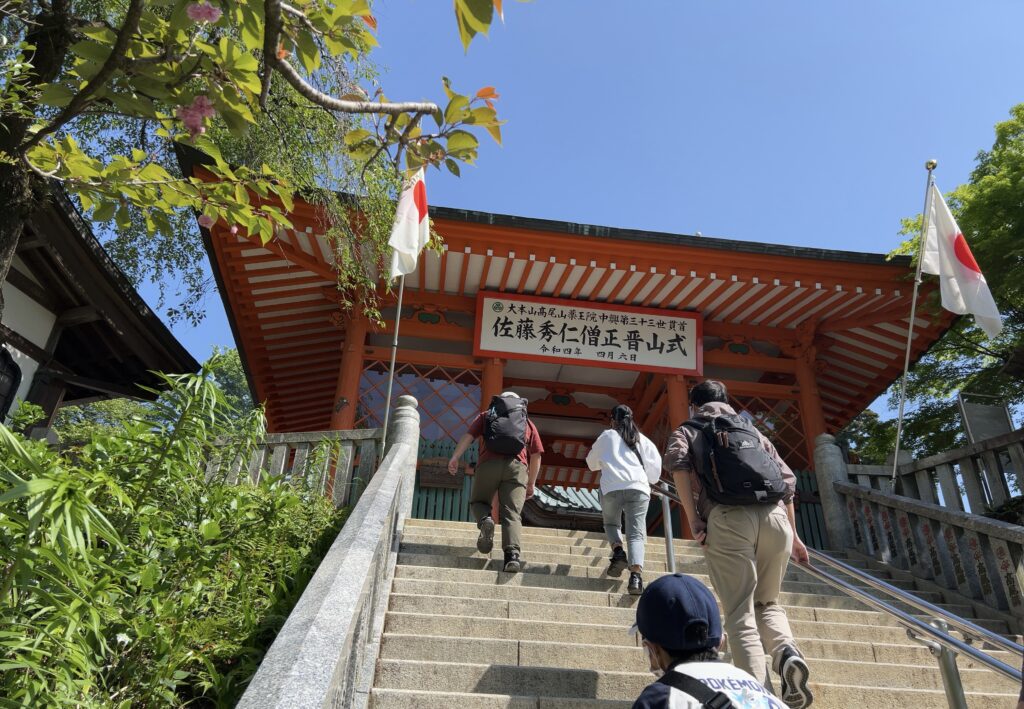
Nio-mon of Yakuo-in Temple is said to have been constructed in the 18th century having the architectural style with a hipped copper roof.
It is designated as one of the tangible cultural assets by the Tokyo Metropolitan Government along with Izuna Gongendo-Hall and other two (2) buildings constructed in the Edo peiord in the grounds of Yakuo-in Temple.
I would say that Shitenno-mon at Yakuo-in Temple is in the minority in Japan in that it is much more common to arrange a pair of Heavenly Kings at a temple gate instead of a quartet.
According to one of my friends in the aviation finance industry from Hong Kong, Shiktenno-mon is more common in China.
Each of the four (4) Heavenly Kings stationed at Shintenno-mon is supposed to protect each of the four cardinal directions.
Although they are actually of Indian origin, they are depicted wearing Chinese style armors just because they have been introduced to Japan through China.
You can see two (2) Heavenly Kings on the front and the other two (2) on the back of this temple gate.
On the front of the gate, you will see on the right from the viewer’s perspective, Jikoku-ten, literally, a god who upholds the realm (Dhrtarastra in Sanskrit).
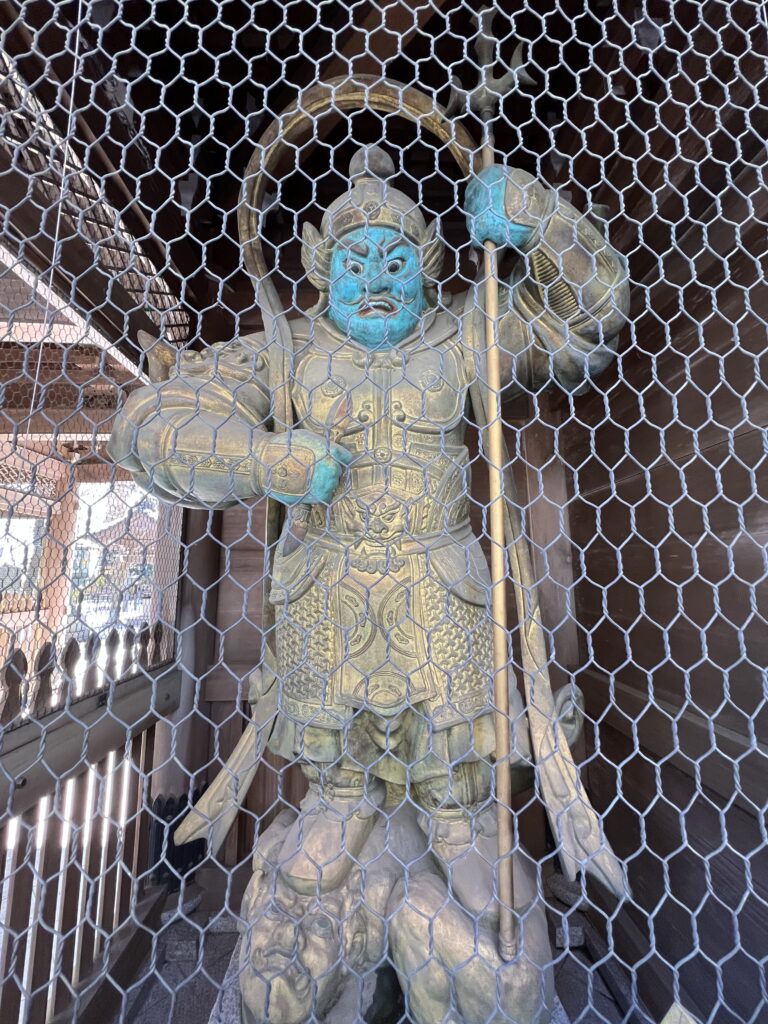
As the Buddhist protector of the eastern quarter, Jikoku-ten is depicted holding a vajra with a pointed end in his right hand and a trident in his left hand.
A vajra was originally a mystical weapon used by a Hindu god called Taishaku-ten (Indra in Sanskrit) who is regarded as the boss of a tough-looking quartet of Heavenly Kings stationed at Shitenno-mon and symbolizes Buddha’s wisdom to destroy worldly sins or desires.
The Heavenly King on the left from the viewer’s perspective, is called Zocho-ten, literally, a god who causes to grow (Virudhaka in Sanskrit).

As the Buddhist protector of the southern quarter, Zocho-ten is depicted holding a sword in his right hand and a precious stone with a figure of flames or Cintamani in Sanskrit (a wish-fulfilling jewel) in his left hand.
Moving on to the other side of the temple gate, the Heavenly King on the right from the viewers’ perspective is called Komoku-ten, literally, a god who sees all (Virupaksa in Sanskrit).

As the Buddhist protector of the western quarter, Komoku-ten is depicted holding a writing brush in his right hand and a scroll of sutra in his left hand, symbolizing the power of Buddha’s teachings to overcome ignorance, evil, and all obstacles.
The Heavenly King on the left from the viewers’ perspective is called Tamon-ten, literally, a god who hears everything (Vaisravana in Sanskrit).
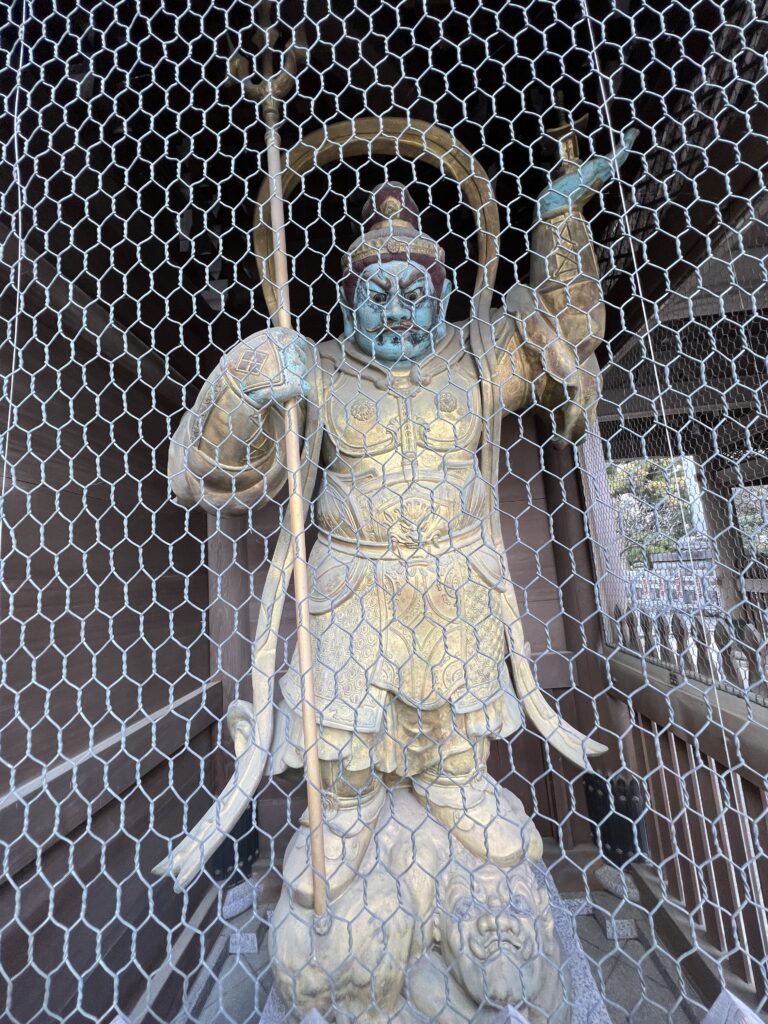
He is said to be the leader of the four Heavenly Kings, with the other three serving as his vassals.
He is also called Bishamon-ten when he is enshrined independently.
As the Buddhist protector of the northern quarter, Tamon-ten is portrayed holding a trident in his right hand and a small pagoda in his left hand, the latter symbolizing the divine treasure house.
In fact, you can see them as guardian deities in many places other than at a Buddhist temple gate.
The following are arguably the most famous statues of Shitenno (Four Heavenly Kings) that are said to have been made in the early 8th century.
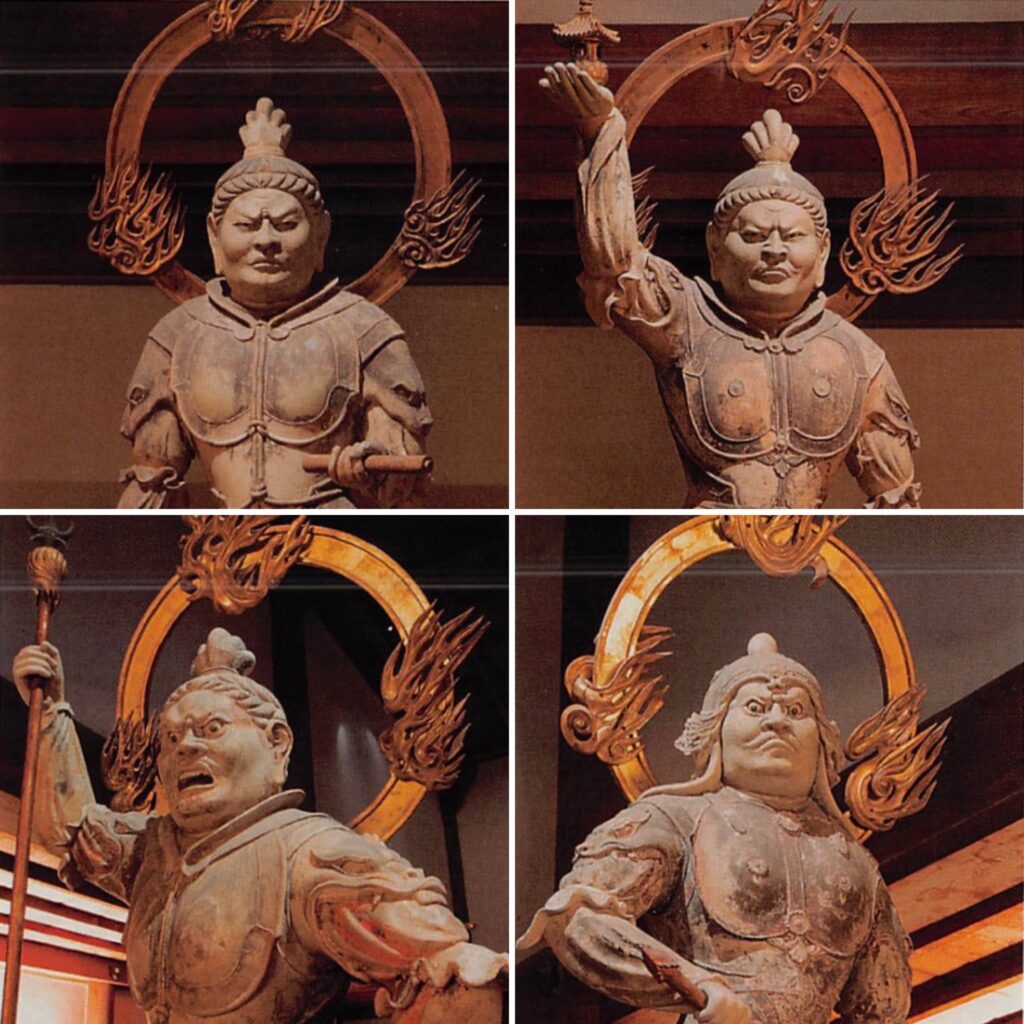
Clockwise from bottom right, they are Jikoku-ten (Dhrtarastra in Sanskrit) protecting the eastern quarter, Zocho-ten (Virudhaka in Sanskrit) protecting the southern quarter, Komoku-ten (Virupaksa in Sanskrit) protecting the western quarter and Tamon-ten (Vaisravana in Sanskrit) protecting the northern quarter.
They are usually housed at Kaidan-do Hall of Todai-ji Temple in Nara that forms a part of “Historic Monuments of Ancient Nara”, one of the World Heritage Sites in Japan (https://whc.unesco.org/en/list/870/).
Their role is to guard the Taho Pagoda housing the statues of Shakyamuni Buddha and Taho Buddha in the Kaidan-do Hall.
These statues are some of my favorite Buddhist statues.
When the Great Buddha Hall of Todai-ji Temple was restored in the late 17th century, after it had been destroyed in the civil war in the late 16 century, the original plan had been that Great Buddha should be guarded by huge statues of Shitenno (Four Heavenly Kings).
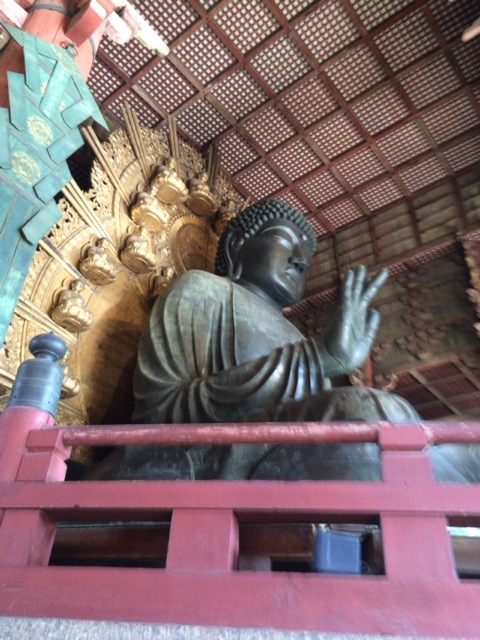
Unfortunately, this plan was not materialized due to the shortage of funds and we can see just two (2) of them behind the statue of Great Buddha.
They are Tamon-ten (Vaisravana in Sanskrit) on the left from the viewers’ perspective and Komoku-ten (Virupaksa in Sanskrit) on the right from the viewers’ perspective as below.
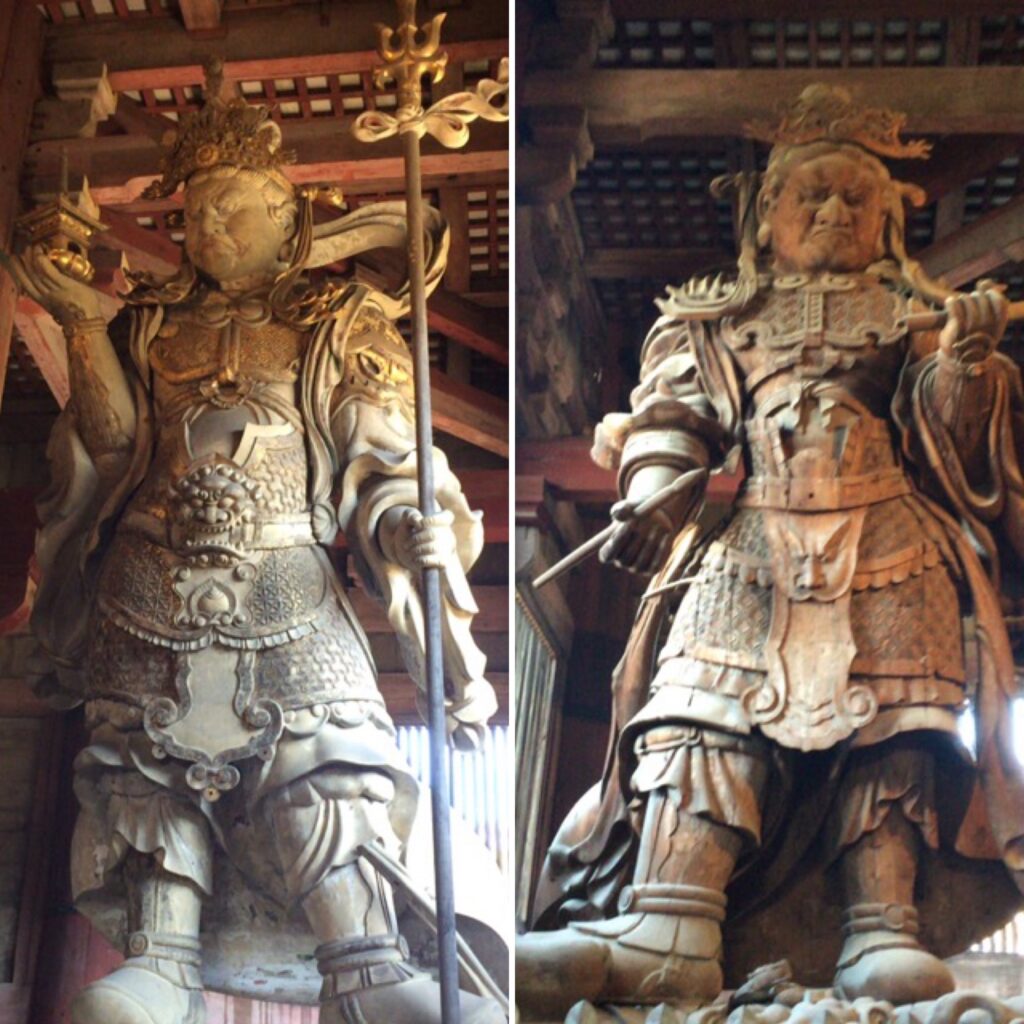
The other two (2) statues have left unfinished so that we can see only their fierce-looking heads at the northeast corner of the Great Buddha Hall.
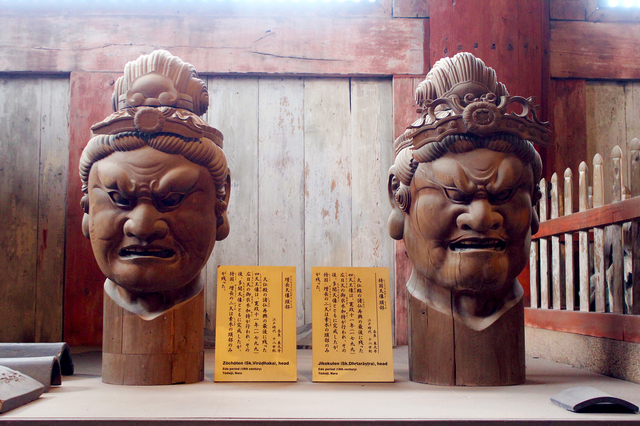
I would say, however, that Great Buddha in Nara should be much more fortunate than its counterpart in Kamakura who has been a homeless Buddha in the open air for more than 600 years since his “mansion” was destroyed by a big earthquake and/or tsunami in the Muromachi period (1336 – 1573).
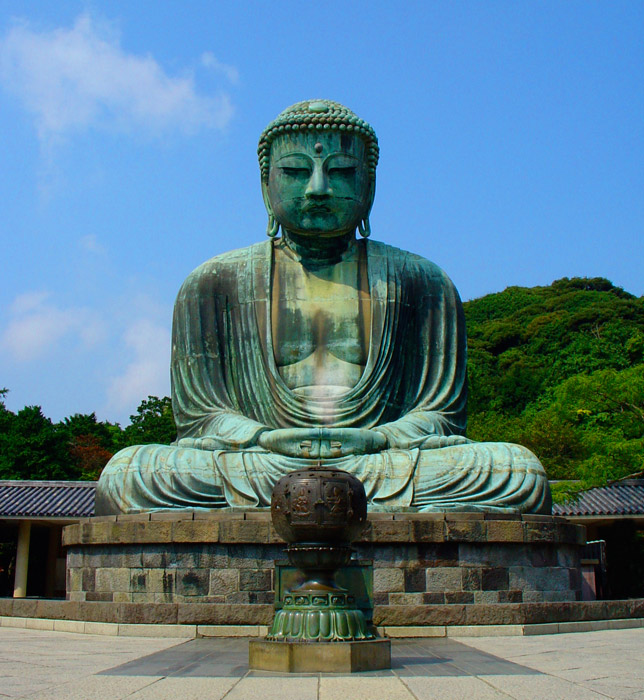

In the 18th century, when the Great Buddha in Kamakura was restored, the original plan included making a lotus pedestal consisting of thirty-two (32) bronze lotus petals for the Great Buddha.
Unfortunately, due to the shortage of donations, only four (4) petals were made and consequently the lotus pedestal has left unfinished.
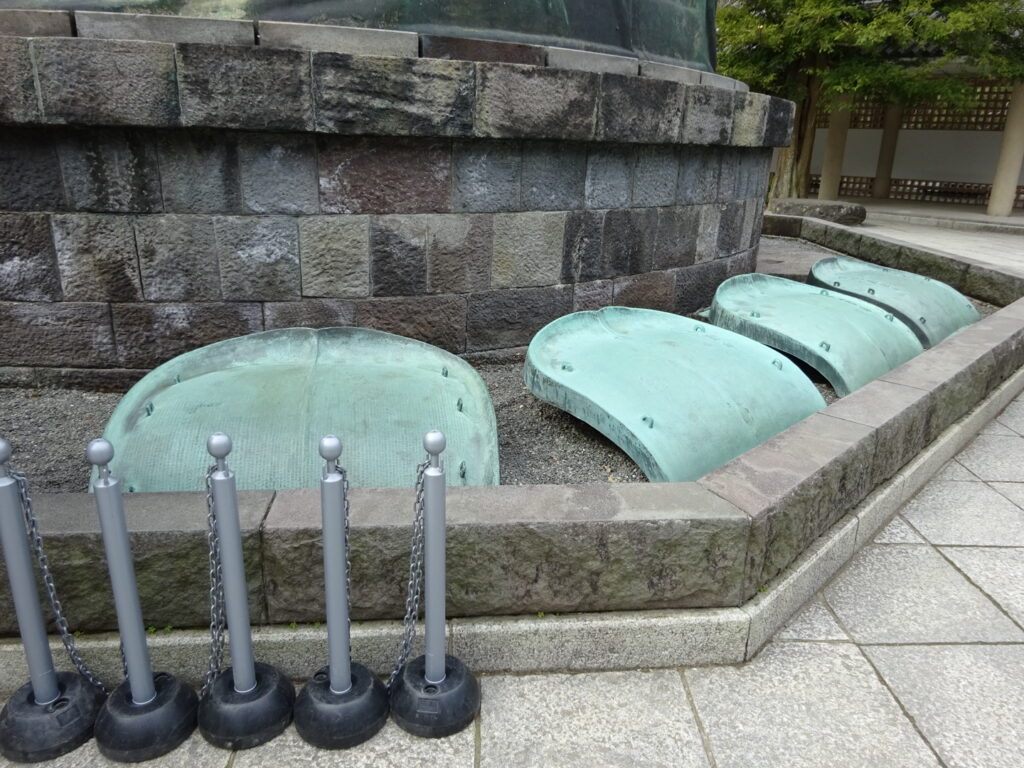
Some of my guests full of curiosity asked me about these four (4) unidentified objects behind the statue of Great Buddha.
A pair of Heavenly Kings at Nio-mon, literally, the Gate of Two Heavenly Kings, are both called Nio, literally, two (2) Heavenly Kings (Vajradhara in Sanskrit which means a god who holds a vajra).
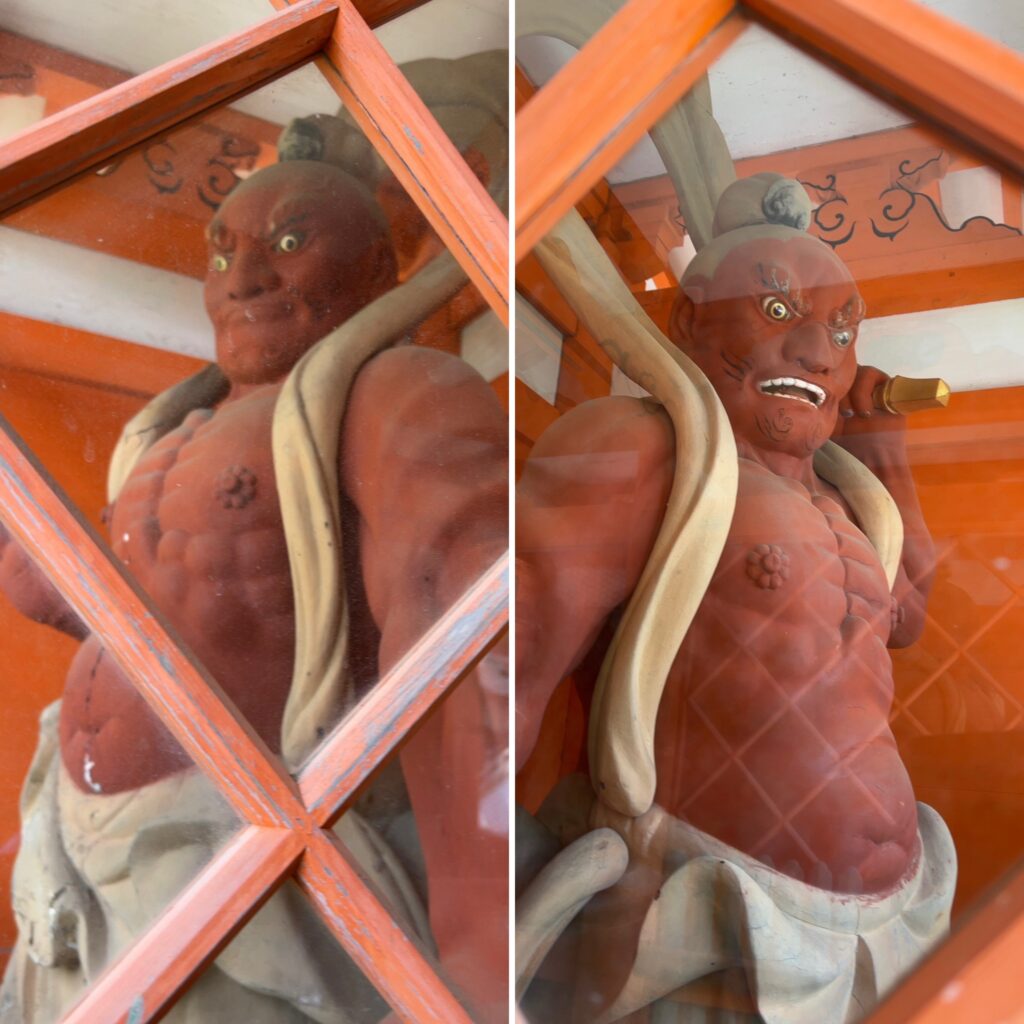
They stand on either side to protect the temple.
As you see, this is another pair of Ah-Un statues.
Since this pair has just one Sanskrit name, we can reasonably assume that unlike a quartet stationed at Shitenno-mon (the Gate of the Four Heavenly Kings) they were originally the same god while in Japan each of them has a different Japanese name (i.e. Naraen Kongo for a open-mouthed statue and Misshaku Kongo for a closed mouthed statue).
As discussed in the post titled Looks like Zendoki (a good boy goblin) is another henpecked husband, for some reasons, the positioning of a pair of Ah-Un style Heavenly Kings at the Great South Gate of Todai-ji Temple, Hozo-mon of Senso-ji Temple in Asakusa, Tokyo and Nio-mon of Zenko-ji Temple in Nagano is all opposite to the normal positioning of Ah-Un statues.

Further, unlike the four Heavenly Kings at Shitenno-mon who all wear Chinese style armors, a pair of Heavenly Kings at Nio-mon are all naked above the waist as if they were directly imported from the tropical India.
There is another type of Buddhist style gate similar to Nio-mon called “Niten-mon“ which is guarded by a pair of the Heavenly Kings wearing Chinese style armors you will see at Shitenno-mon (in most of the cases, a combination of Jikoku-ten (Dhrtarastra) and Tamon-ten (Vaisravana)) instead of a pair of Heavenly Kings that are naked above the waist (Vajradhara).
Having said that, some of the Niten-mons are guarded by a different combination of four (4) Heavenly Kings such as a combination of Jikoku-ten (Dhrtarastra) and Zocho-ten (Virudhaka) which is the case with Senso-ji Temple in Asakusa, Tokyo.
After the Meiji Restoration, some of the Shinto shrines demolished its Nio-mon or converted it into Shinto style Zuijin-mon by replacing Nio (Two Heavenly Kings of Indian origin) with a Shinto style guardian deities called Zuijin.

Zuijin generally refers to the statues which are dressed in the costume of military officers of Inner Palace Guards.

At Zuijin-mon, you will see a pair of Zuijin, typically, one in the costume of the Middle Captain of the Left Division of Inner Palace Guards on the left from the perspective of those who are sitting and the other in the costume of the Minor Captain of the Right Division of Inner Palace Guards from the perspective of those who are sitting in accordance with the Principle of Left Over Right.
Tsurugaoka Hachiman-gu Shrine which is the landmark of Kamakura, where the very first samurai government was established in the late 12th century, had been called Tsurugaoka Hachiman-gu Shrine Temple before the Meiji Restoration.
In its precincts, there used to be a Nio-mon which does not exist any longer while Zujijin-mon has survived the revolutionary changes in the religious world caused as the result of the Meiji Restoration.
The following is a photo of Zuijin-mon at Tsukuba-san Shrine in Tsukuba City in Ibaraki prefecture which had been a Nio-mon before the Meiji Restoration and a pair of Heavenly Kings have been replaced with a pair of the statues of legendary Japanese ancient gods called Yamato Takeru and Toyoki Irihiko wearing more classic Japanese armors.

The bottom line is that after the Meiji Restoration the most common Buddhist temple gates have been Nio-mon guarded by a pair of Heavenly Kings (Vajradhara) and the most common Shinto gates have been Zuijin-mon guarded by a pair of Zujin.
Some of you may notice that Buddhist Temples in the popular tourist destinations are only open roughly from 9 am to 4 – 5 pm and charge some admission fees while Shinto shrines are open 24 hours and charge no admission fees.
So, when I guide my guest(s) in Kamakura, my practice is to leave the visit to Tsurulgaoka Hachiman-gu Shrine later.
We could say that playing a role of a gatekeeper at Shinto shrines should be much tougher than at Buddhist temples due to much longer (or never ending?) working hours.
Yakuo-in Temple in Mt. Takao does not charge any admission fees while it is open generally from 8:30 am to 4:00 pm.
As you remember, Mt. Takao is a sacred mountain of Shugendo that is the product of fusion of Buddhism and Shinto.
As discussed in the post titled A pair of Komainu as another symbol of Shinto, as a gatekeeper Komainu is much more flexible than Nio and Zuijin by playing in both Shinto and Buddhist worlds even after the Meiji Restoration.
They are two-way players like Shohei Otani who is a Japanese professional baseball pitcher and designated hitter for the Los Angeles Angels of Major League Baseball.
